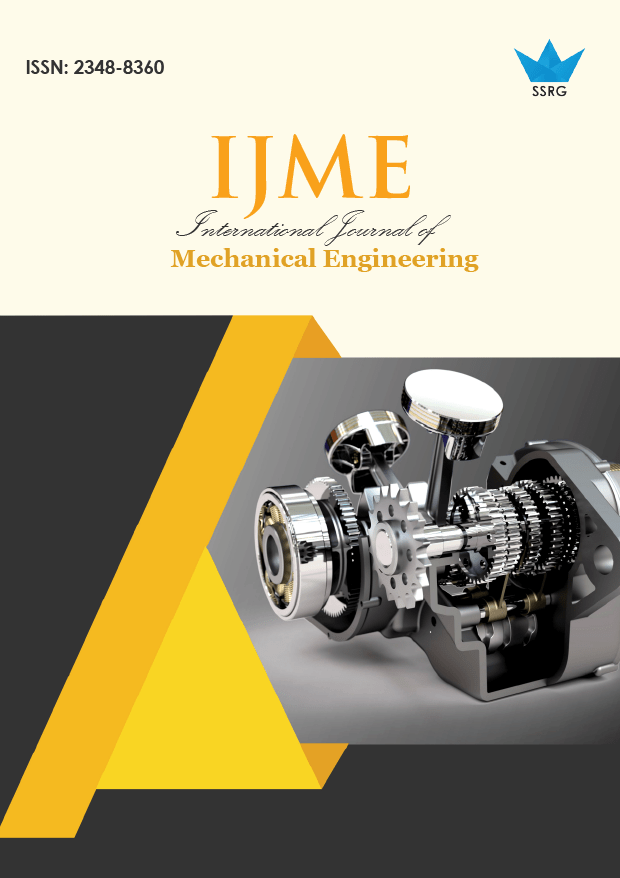Exploring the Tribological, Physiological, and Morphological Properties of Peanut Shell Reinforced Epoxy Bio-Composites

| International Journal of Mechanical Engineering |
| © 2025 by SSRG - IJME Journal |
| Volume 12 Issue 10 |
| Year of Publication : 2025 |
| Authors : Rameshkumar H. Bhoi, Sumit Das Lala, Payel Deb |
How to Cite?
Rameshkumar H. Bhoi, Sumit Das Lala, Payel Deb, "Exploring the Tribological, Physiological, and Morphological Properties of Peanut Shell Reinforced Epoxy Bio-Composites," SSRG International Journal of Mechanical Engineering, vol. 12, no. 10, pp. 22-29, 2025. Crossref, https://doi.org/10.14445/23488360/IJME-V12I10P103
Abstract:
Wear, friction, and lubrication are key components of surface interactions between moving parts. The study of these interactions is known as tribology. It plays a major role in reducing energy loss caused by friction in mechanical systems. A significant portion of energy is wasted due to friction at sliding interfaces, making it essential to develop innovative strategies to minimize both wear and friction in tribological systems. Advancements in this field are critical in fostering a more sustainable and eco-friendly future. This article presents extensive research on the tribological efficacy of peanut shell powder reinforced epoxy bio-composite. The composite samples were characterized using wear properties in dry conditions and surface roughness for different ratios of epoxy resin and peanut shell powder, such as 5% wt., 10% wt., 15% wt., and 20% wt. This developed composite material highlights its potential for enhancing efficiency and sustainability in various applications.
Keywords:
Tribology, Peanut shell, Bio-composites, Natural filler, Epoxy resin.
References:
[1] J. Rout, “The Influence of Fibre Treatment on the Performance of Coir-Polyester Composites,” Composites Science and Technology, vol. 61, no. 9, pp. 1303-1310, 2001.
[CrossRef] [Google Scholar] [Publisher Link]
[2] A.K. Rana, A. Mandal, and S. Bandyopadhyay, “Short Jute Fiber Reinforced Polypropylene Composites: Effect of Compatibiliser, Impact Modifier and Fiber Loading,” Composites Science and Technology, vol. 63, no. 6, pp. 801-806, 2003.
[CrossRef] [Google Scholar] [Publisher Link]
[3] S.V. Joshi et al., “Are Natural Fiber Composites Environmentally Superior to Glass Fiber Reinforced Composites?,” Composites Part A: Applied Science and Manufacturing, vol. 35, no. 3, pp. 371-376, 2004.
[CrossRef] [Google Scholar] [Publisher Link]
[4] Sanjay K. Nayak, Smita Mohanty, and Sushanta K. Samal, “Influence of Short Bamboo / Glass Fiber on the Thermal, Dynamic Mechanical and Rheological Properties of Polypropylene Hybrid Composites,” Materials Science and Engineering: A, vol. 523, no. 1-2, pp. 32-38, 2009.
[CrossRef] [Google Scholar] [Publisher Link]
[5] V.A. Bely, A.I. Sviridenok, and M.I. Petrokovets, Friction and Wear in Polymer-Based Materials, Pergamon, pp. 1-426, 2013.
[Google Scholar] [Publisher Link]
[6] I.V. Kragelsky, and V.V. Alisin, Tribology-Lubrication, Friction and Wear, Tribology, Willey, pp. 1-948, 2001.
[Google Scholar] [Publisher Link]
[7] Hamid Essabir et al., “Biocomposites Based on Argan Nut Shell and a Polymer Matrix: Effect of Filler Content and Coupling Agent,” Carbohydrate Polymers, vol. 143, pp. 70-83, 2016.
[CrossRef] [Google Scholar] [Publisher Link]
[8] Fatima Zahra El Mechtali et al., “Mechanical and Thermal Properties of Polypropylene Reinforced with Almond Shells Particles: Impact of Chemical Treatments,” Journal of Bionic Engineering, vol. 12, pp. 483-494, 2015.
[CrossRef] [Google Scholar] [Publisher Link]
[9] Diène Ndiaye, Mamadou Gueye, and Bouya Diop, “Characterization, Physical and Mechanical Properties of Polypropylene/Wood-Flour Composites,” Arabian Journal for Science and Engineering, vol. 38, pp. 59-68, 2013.
[CrossRef] [Google Scholar] [Publisher Link]
[10] S.M. Sapuan, M. Harimiand, and M.A. Maleque, “Mechanical Properties of Epoxy/Coconut Shell Filler Particle Composites,” Arabian Journal for Science and Engineering, vol. 28, no. 2, pp. 171-182, 2003.
[Google Scholar]
[11] Satta Panyakaew, and Steve Fotios, “321: Agricultural Waste Materials as Thermal Insulation for Dwellings in Thailand: Preliminary Results,” Proceedings of the 25th Conference on Passive and Low Energy Architecture, Dublin, Ireland, pp. 22-24, 2008.
[Google Scholar]
[12] S.O. Adeosun et al., “Influence of Organic Fillers on Physicochemical and Mechanical Properties of Unsaturated Polyester Composites,” Arabian Journal for Science and Engineering, vol. 41, pp. 4153-4159, 2016.
[CrossRef] [Google Scholar] [Publisher Link]
[13] Khalil Ahmed, “Eco-Thermoplastic Elastomer Blends Developed by Compatibilizing Chlorinated Polyethylene into Industrial-Waste-Filled Polypropylene/Acrylonitrile Butadiene Rubber System,” Arabian Journal for Science and Engineering, vol. 40, pp. 2929-2936, 2015.
[CrossRef] [Google Scholar] [Publisher Link]
[14] H. Essabir et al., “Mechanical and Thermal Properties of Bio-Composites Based on Polypropylene Reinforced with Nut-Shells of Argan Particles,” Materials & Design, vol. 49, pp. 442-448, 2013.
[CrossRef] [Google Scholar] [Publisher Link]
[15] Kaimeng Xu et al., “Effects of Environmental-Friendly Modified Rubber Seed Shell on the Comprehensive Properties of High Density Polyethylene/Rubber Seed Shell Composites,” Industrial Crops and Products, vol. 91, pp. 132-141, 2016.
[CrossRef] [Google Scholar] [Publisher Link]
[16] Hamid Essabir et al., “Morphological, Structural, Thermal and Tensile Properties of High Density Polyethylene Composites Reinforced with Treated Argan Nut Shell Particles,” Journal of Bionic Engineering, vol. 12, pp. 129-141, 2015.
[CrossRef] [Google Scholar] [Publisher Link]
[17] E. García et al., “Mechanical, Dynamic and Tribological Characterization of HDPE / Peanut Shell Composites,” Polymer Testing, vol. 98, pp. 1-13, 2021.
[CrossRef] [Google Scholar] [Publisher Link]
[18] Emad Omrani et al., “State of the Art on Tribological Behavior of Polymer Matrix Composites Reinforced with Natural Fibers in the Green Materials World,” Engineering Science and Technology, an International Journal, vol. 19, no. 2, pp. 717-736, 2016.
[CrossRef] [Google Scholar] [Publisher Link]
[19] Olga Mysiukiewicz, and Tomasz Sterzyński, “Influence of Water on Tribological Properties of Wood-Polymer Composites,” Archives of Mechanical Technology and Materials, vol. 37, pp. 79-84, 2017.
[Google Scholar] [Publisher Link]
[20] Narish Singh, B.F. Yousif, and Dirk Rilling, “Tribological Characteristics of Sustainable Fiber-Reinforced Thermoplastic Composites under Wet Adhesive Wear,” Tribology Transactions, vol. 54, no. 5, pp. 736-748, 2011.
[CrossRef] [Google Scholar] [Publisher Link]
[21] L. Sobczak, O. Brüggemann, and R.F. Putz, “Polyolefin Composites with Natural Fibers and Wood-Modification of the Fiber/Filler–Matrix Interaction,” Journal of Applied Polymer Science, vol. 127, no. 1, pp. 1-17, 2013.
[CrossRef] [Google Scholar] [Publisher Link]
[22] Kamal B. Adhikary, Shusheng Pang, and Mark P. Staiger, “Dimensional Stability and Mechanical Behaviour of Wood–Plastic Composites Based on Recycled and Virgin High-Density Polyethylene (HDPE),” Composites Part B: Engineering, vol. 39, no. 5, pp. 807-815, 2008.
[CrossRef] [Google Scholar] [Publisher Link]
[23] Slawomir Borysiak, “Fundamental Studies on Lignocellulose / Polypropylene Composites: Effects of Wood Treatment on the Transcrystalline Morphology and Mechanical Properties,” Journal of Applied Polymer Science, vol. 127, no. 2, pp. 1309-1322, 2013.
[CrossRef] [Google Scholar] [Publisher Link]
[24] Naresh Kumar et al., “Experimental Investigation on the Physical, Mechanical and Tribological Properties of Hemp Fiber-Based Non-Asbestos Organic Brake Friction Composites,” Materials Research Express, vol. 6, no. 8, 2019.
[CrossRef] [Google Scholar] [Publisher Link]
[25] Wang Zhen-Yu et al., “Influence of Banana Fiber on Physicomechanical and Tribological Properties of Phenolic Based Friction Composites,” Materials Research Express, vol. 6, no. 7, 2019.
[CrossRef] [Google Scholar] [Publisher Link]
[26] Yunhai Ma et al., “Tribological and Physio-Mechanical Characterization of Cow Dung Fibers Reinforced Friction Composites: An Effective Utilization of Cow Dung Waste,” Tribology International, vol. 131, pp. 200-211, 2019.
[CrossRef] [Google Scholar] [Publisher Link]
[27] Faissal Chegdani, Satish T.S. Bukkapatnam, and Mohamed El Mansori, “Thermo-Mechanical Effects in Mechanical Polishing of Natural Fiber Composites,” Procedia Manufacturing, vol. 26, pp. 294-304, 2018.
[CrossRef] [Google Scholar] [Publisher Link]
[28] C.U. Atuanya et al., “Empirical Models for Estimating the Mechanical and Morphological Properties of Recycled Low Density Polyethylene/snail Shell Bio-Composites,” Journal of the Association of Arab Universities for Basic and Applied Sciences, vol. 21, pp. 45-52, 2016.
[CrossRef] [Google Scholar] [Publisher Link]
[29] Yahya Tasgin et al., “Mechanical, Wear and Thermal Properties of Natural Fiber-Reinforced Epoxy Composite: Cotton, Sisal, Coir and Wool Fibers,” Journal of Material Science, vol. 59, pp. 10844-10857, 2024.
[CrossRef] [Google Scholar] [Publisher Link]
[30] C. Girisha et al., “Mechanical Performance of Natural Fiber-Reinforced EpoxyHybrid Composites,” International Journal of Engineering Research and Applications (IJERA), vol. 2, no. 5, pp. 615-619, 2012.
[Google Scholar] [Publisher Link]
[31] K. Begum, and A.M. Islam, “Natural Fiber as a substitute to Synthetic Fiber in Polymer Composites: A Review,” Research Journal of Engineering Sciences, vol. 2, no. 3, pp. 46-53, 2013.
[Google Scholar] [Publisher Link]
[32] Ojha Shakuntala, Gujjala Raghavendra, and Acharya Samir Kumar, “Effect of Filler Loading on Mechanical and Tribological Properties of Wood Apple Shell Reinforced Epoxy Composite,” Advances in Materials Science and Engineering, vol. 2014, no. 1, pp. 1-9, 2014.
[CrossRef] [Google Scholar] [Publisher Link]
[33] Hanafi Ismail, M.R. Edyham, and B. Wirjosentono, “Bamboo Fibre Filled Natural Rubber Composites: The Effects of Filler Loading and Bonding Agent,” Polymer Testing, vol. 21, no. 2, pp. 139-144, 2002.
[CrossRef] [Google Scholar] [Publisher Link]

 10.14445/23488360/IJME-V12I10P103
10.14445/23488360/IJME-V12I10P103